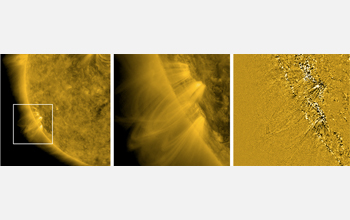Press Release 11-003
Longstanding Mystery of Sun's Hot Outer Atmosphere Solved

Longstanding Mystery of Sun's Hot Outer Atmosphere Solved
Answer lies in jets of plasma
January 6, 2011
One of the most enduring mysteries in solar physics is why the Sun's outer atmosphere, or corona, is millions of degrees hotter than its surface.
Now scientists believe they have discovered a major source of hot gas that replenishes the corona: jets of plasma shooting up from just above the Sun's surface.
The finding addresses a fundamental question in astrophysics: how energy is moved from the Sun's interior to create its hot outer atmosphere.
"It's always been quite a puzzle to figure out why the Sun's atmosphere is hotter than its surface," says Scott McIntosh, a solar physicist at the High Altitude Observatory of the National Center for Atmospheric Research (NCAR) in Boulder, Colo., who was involved in the study.
Pictured above: Narrow jets of material, called spicules, streak upward from the Sun's surface at high speeds.
Credit NASA
Jets of plasma from just above the Sun's surface
likely replenish its corona.
Credit: NASA
The research, results of which are published this week in the journal Science, was conducted by scientists from Lockheed Martin's Solar and Astrophysics Laboratory (LMSAL), NCAR, and the University of Oslo. It was supported by NASA and the National Science Foundation (NSF), NCAR's sponsor.
"By identifying that these jets insert heated plasma into the Sun's outer atmosphere, we can gain a much greater understanding of that region and possibly improve our knowledge of the Sun's subtle influence on the Earth's upper atmosphere."
Spicule Hotspot
Spicules on the sun, as observed by the Solar Dynamics Observatory. These bursts of gas jet off the surface of the sun at 150,000 miles per hour and contain gas that reaches temperatures over a million degrees.
Credit: NASA Goddard/SDO/AIA http://www.nasa.gov/mission_pages/sdo/news/news20110106-spicules.html
Credit: NASA Goddard/SDO/AIA http://www.nasa.gov/mission_pages/sdo/news/news20110106-spicules.html
Hotspots in Fountains on the Sun's Surface Help Explain Coronal Heating Mystery
01.06.11
Thanks to NASA's Solar Dynamics Observatory (SDO) and the Japanese satellite Hinode, these spicules have recently been imaged and measured better than ever before, showing them to contain hotter gas than previously observed. Thus, they may perhaps play a key role in helping to heat the sun's corona to a staggering million degrees or more. (A number made more surprising since the sun's surface itself is only about 10,000 degrees Fahrenheit.)



No comments:
Post a Comment